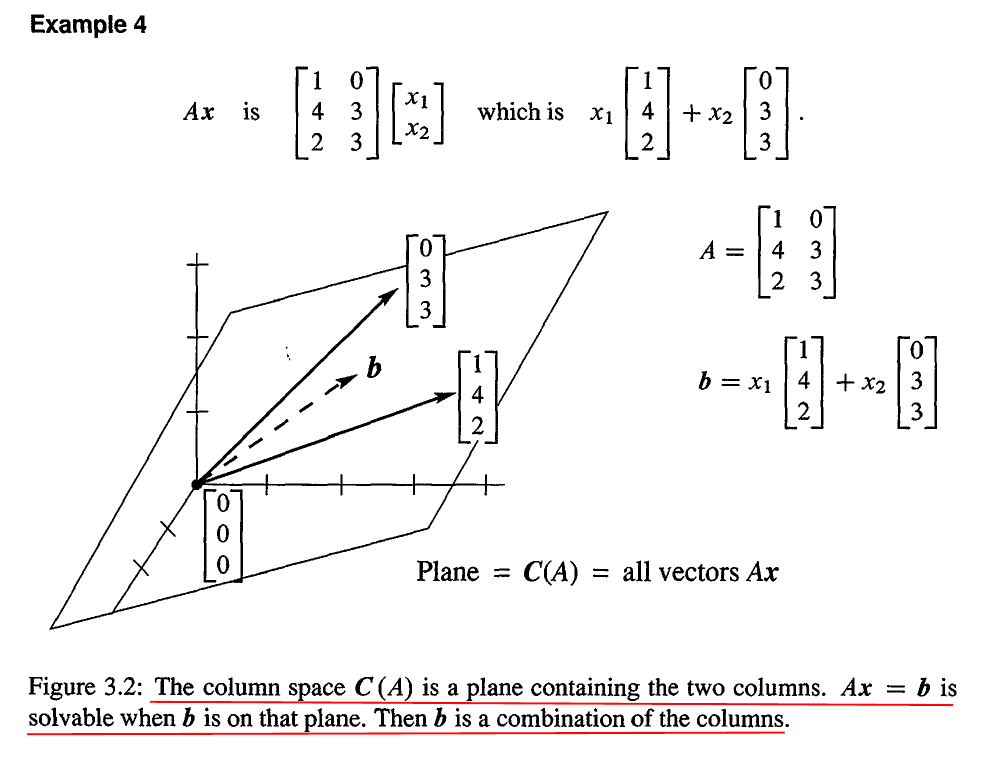1. 向量空间和子空间
向量空间 Rn 由所有的 n 维向量 v 组成,向量中的每个元素都是实数。
向量空间 R2 可以用 xy 平面来表示,其中的每个向量有两个元素,它们定义了平面上一个点的坐标。
在一个向量空间中,如果我们将任意向量相加或者乘以一个标量,也就是任意向量的线性组合,它们的结果仍然在这个向量空间中。
三维空间中过原点的一个平面是一个向量空间,这个向量空间和 R2 很像,但其中的每个向量都有三个元素。如果我们对这个平面中的两个向量相加,那结果仍然在这个平面中。如果我们对其中的一个向量乘以一个常数,结果也仍然在这个平面中。这个平面位于 R3 向量空间里,称为 R3 的子空间。
一个向量空间的子空间是由一系列包含零向量的向量组成的,并且满足:如果是 v 和 w 是子空间的两个向量并且 c 是任意标量,那么有 (1) v+w在子空间中, (2) cv 在子空间中。
也就是说,所有向量的线性组合都仍然在这个子空间中。
R3 的所有可能子空间有:
- L 所有过 (0, 0, 0) 的直线
- P 所有过 (0, 0, 0) 的平面
- Z 只有零向量 (0, 0, 0)
- R3 整个空间
一个最重要的子空间是和矩阵 A 紧密联系的。当我们求解 Ax=b 时, Ax 是对 A 的列的线性组合。为了得到 b,我们用任何可能的 x 来求取 A 的列的所有可能的线性组合,这产生了一个 A 的列空间 C(A)。 C(A) 不仅仅包含 A 的所有列向量,还包括他们的所有线性组合。
因此,当我们求解 Ax=b 时,如果 b 存在于 A 的列空间中的话,我们就可以找到一组系数,使得它们对 A 的列的线性组合就是 b,否则,方程就无解。

2. A 的零空间
矩阵 A 的零空间包含所有 Ax=0 的解,这些向量位于 Rn 中,表示为 N(A)。
假设 x 和 y 位于矩阵 A 的零空间中,也就是 Ax=0、 Ay=0,那就有 A(x+y)=0、 A(cx)=0,即它们相加或者乘以一个标量后仍然在零空间中,因此零空间是一个子空间。
零空间是所有特解的线性组合。
平面 x+2y+3z=0 可以表示为
[123]⎣⎡xyz⎦⎤=0
上述方程的两个特解分别为
s1=⎣⎡−210⎦⎤,s2=⎣⎡−301⎦⎤
向量 s1 和 s2 位于平面 x+2y+3z=0 中,这个平面就是矩阵 A=[123] 的零空间,这个平面上的所有向量都是 s1 和 s2 的线性组合。
注意到,上述特解的最后两个元素分别为 0 和 1,这些元素是自由的并且是我们特殊选择的。因为矩阵 A=[123] 的第一列包含一个主元,因此特解的第一个元素是不自由的,自由的元素就对应着该列没有主元。
3. 消元法求解 Ax=0
这时候,矩阵 A 是矩形的,我们求解有 n 个未知数的 m 个方程。
A=⎣⎡123123281031013⎦⎤
第一个主元是 1,然后我们需要将主元下面的 2 和 3 变成 0。
A→⎣⎡100100244344⎦⎤
这时候,第二列主元的位置为 0,并且其下面的位置也为 0,因此我们也无法用行交换来得到一个主元。
这意味着我们遇到了问题,但我们不应该停止,我们继续看第三列。我们得到了第二个主元 4,然后继续向下消元得到下三角矩阵 U。
U=⎣⎡100100240340⎦⎤
由于第 1 列和第 3 列包含主元,因此主变量就是 x1 和 x3,而 x2 和 x4 是自由变量。
这时候,我们分别将两个自由变量设为 0 和 1,就可以得到方程的解为

针对每个自由变量都有一个与之对应的特解,所有特解的线性组合就是零空间 N(A)。如果没有一个变量是自由的,这就意味着方程组只有一个零向量解。
若是 n>m,即列数大于行数,那肯定至少有一个变量是自由的,因为每一行最多只有一个主元,这也就意味着方程组有至少一个特解,这个解是非零的。
对上面的下三角矩阵 U 继续进行消元,第二行除以 4,然后第一行减去第二行的 2 倍,我们可以得到简化行阶梯形式 R
R=⎣⎡100100010110⎦⎤
这时候,特解就可以很容易地从 R 中读出来,第一个特解的 -1 和 0 就是 R 中第二列的元素 1 和 0 取负号,第二个特解的 -1 和 1 就是 R 中第四列的元素 1 和 1 取负号。
另外,在 R 的左边乘以任意可逆的矩阵,不会改变其零空间。
获取更多精彩,请关注「seniusen」!








 京公网安备 11010502036488号
京公网安备 11010502036488号